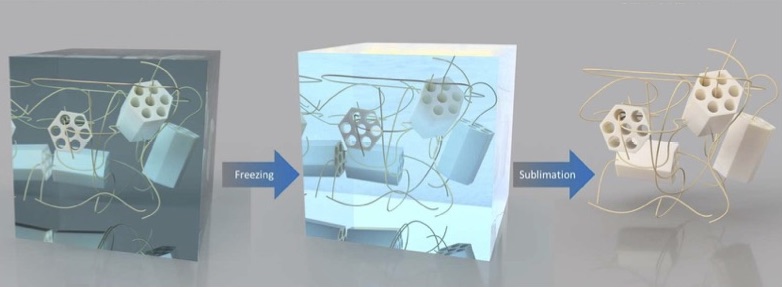Finding non-cytotoxic carrier materials that ensure a controlled release of an active hydrophobic drug over a long period of time is considered to be the “holy grail” in wound dressing applications. A team of researchers from Brazil and the USA report to have found a material that combines all of those desired characteristics.
The novel silica-polymer hybrid (SPH) aerogels, synthesized from silica nanoparticles, polyvinyl alcohol (PVA), polyacrylic acid (PAA), and water, were manufactured via freeze-drying and subsequent thermal treatment (see Figure below). While the freeze-drying ensured a complete removal of water, the ensuing thermal treatment at 160 °C facilitated the cross-linking between PVA and PAA, guaranteeing aerogel stability in aqueous media.
Experiments conducted with dexamethasone (DEX), an agent used for the treatment of skin diseases, allergies, and rheumatic problems, showed that the SPH aerogels exhibit high drug encapsulation efficiencies, taking up around 75 % of DEX from an ethanol/water mixture within 24 hours. This feature was ascribed to the trapping of DEX molecules within the mesoporous silica nanoparticles.
The release rate of DEX from the aerogels was investigated by placing the loaded samples into a stirred phosphate buffered saline (PBS) solution at 37 °C and measuring the progression of the DEX concentration with time. These measurements showed that after an initial rapid discharge of DEX, the release rate leveled off, so that even after two months a steady drug discharge was obtained. This slow and prolonged release of DEX molecules was attributed to the polymer pore structure, limiting the mass transfer from the drug encapsulation site (silica nanoparticles) to the solution. Supporting this finding were results for SPH aerogels of a different constitution, which showed that a change in PVA:PAA ratio, yielding morphological modifications of the polymer pore network, leads to a significant change in drug release behavior.
In order to assess the biocompatibility and cytotoxicity of the synthesized material, the cell viability of vero cells and L929 fibroblasts was investigated in the presence of the SPH aerogels. This line of experiment showed that there is virtually no decrease in cell viability for either cell type after 72 hours, regardless of precursor selection.
The authors see potential applications of SPH aerogels in the treatment of skin burns or melanoma, which require wound dressing over extended periods of time. Furthermore, they see potential in tailoring the aerogel structures (e.g. with antibodies) to further extend their potential biological and medical applications.
More details: Follmann et al.; Multifunctional Hybrid Aerogels: Hyperbranched Polymer- Trapped Mesoporous Silica Nanoparticles for Sustained and Prolonged Drug Release, Nanoscale, December 2017. http://doi.org/10.1039/C7NR08464A

